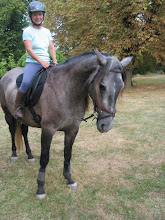It is now understood in sports coaching that the more naturally able the athlete/performer, the less likely they are to know HOW they do what they do so well. A huge amount of what makes them so good is unconscious. (They don't even have to think about it, leaving them “brainspace” for refining their skills)
But it’s just those fundamental bits that most ordinary riders lack. Think of it like this. If good riding is like baking a cake, talented riders already have the cake and can work on icing it, but most riders don’t need icing instructions (yet), they need the basic recipe for making
the cake… how much flour? Do they need eggs? etc.
The result of Mary’s research is RIDE WITH YOUR MIND, a constantly evolving way of coaching riders the key pieces that underpin riding, and coaching them in bite-sized chunks that riders can assimilate.
On RWYM clinics riders learn that HOW THEY ORGANISE THEIR BODY IS THE PRIMARY WAY IN WHICH THEY CAN INFLUENCE THE HORSE.
Mary teachinginternational Grand Prix dressage rider, HeatherBlitz
Nearly all instructors agree about the importance of having a good position, but many aren’t consciously aware of how critically this influences the horse, or of how to convey the complex ingredients that go together to make up that “position”.
A RWYM coach will help you to organise your body in a very precise, conscious way (hence Ride With Your MIND). Piece by piece, the coach will help you to use your primary
communication toolkit (that’s your body) to enable you to influence your horse’s carriage in an apparently talented way.
Each rider has their own body disorganisation to deal with, which unbalances the horse and sends him conflicting signals, making the rider part of the problem, rather than part of the
solution. But as the rider learns to maintain the correct mechanics, the effect on the horse is to have him lift his back and reach into the rein, in classically correct carriage. (As opposed to the horrible experience, of creating a hollow-backed horse with his head pulled in. Without correct mechanics riders and horses are doomed to this, and never get to experience the magic of being so in place that the horse chooses to carry himself with freedom and lightness).
Much of the traditional riding lore, presupposes that you as a rider already have your basic pieces in place, and that you are already able to organise your body in the right ways, so you can go on to organise and school the horse.
If you are taught by an instructor who is a talented rider, (and many of them are), they may struggle to convey to you HOW to do it, because in their body a lot of what makes it work just happens. If they got on and did what they were telling you to do it would work. But, and it is a huge but, most riders’ body organisation skills are nothing like their instructors. – Yet RWYM sets out to fill this gap.
Imagine that good riding is a wonderful place, a place people want to get to, like Paris in France. The directions they will require to get there will depend upon where they start from. It is no good giving someone from Jo’burg the same directions as someone from London or Tokyo. Conventional instruction tends to assume that because everybody is aiming for the same place, they need the same instructions. RWYM coaches help riders to map the territory that THEY need to cross to get to good riding wherever their start point is.
Of course some riders start much closer to the goal, and that’s wonderful, but RWYM doesn’t believe that starting from along way away should mean that you can¹t make the trip. RWYM coaches will also respect you enough not to lie to you about the distance you need to travel!
People who come on RWYM clinics do ridden work, dismounted workshops, and watch video feedback.
They say that the degree to which they need to be able to control their own bodies in order to ride is far more precise than they ever realised. They will also tell you just how weird it feels to organise themselves in the right way when that wasn’t their
usual body pattern. They rave about the way they have been coached and shown how to achieve a result, rather than just being told to do a particular
action. They also rave about the amazing difference they can make in a horse when they get themselves in place.
More advanced riders are equally amazed that with even better body organisation they can overcome persistent training problems, and develop the quality of their horse’s work. Riders come out of clinics with an awareness of what an organisational challenge it is to ride well, and the pieces that they need to begin the journey towards good riding - should they choose to accept that challenge.
They are often realising for the first time the gap between their “toolkit” and what
is required of them by a horse if he is to perform well.
However, they are usually very excited that they can close that gap, and that good riding is attainable if they practice and build on the pieces they have learned. Many feel that they are no longer doomed to the scrapheap of seemingly untalented riders, or to unhappily pulling a horse’s head in, in an attempt to get it on the bit.
Moreover, given time to get their body organisation established, they report that they are far more able to do what their trainer wants, and to have the effect on the horse that their teacher so wanted for them all along.


